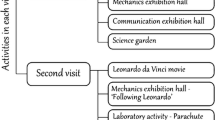Abstract
This article describes an initial attempt to find out students’ perceptions of class visits to natural history museums, with regard to the museum’s role as a place for intellectual and social experience. The study followed up approximately 500 Grades 6–8 students who visited four museums of different sizes, locations and foci. Data sources included the Museum Constructivist Learning Environment Survey (M-CLES), which was adapted from Constructivist Learning Environment Survey, an open-ended question and semi-structured interviews with 50 students. The three instruments highlighted some differences in students’ perceptions of the visit. Opportunities for concrete experiences and cognitive and affective engagement were not covered by the M-CLES, while the nature of science was not discussed by the students in their responses to the open-ended item and the interviews. This suggests that each instrument has its advantages and limitations and, therefore, the three means for data collection enabled a complementary view. Based on our findings, we suggest further development of museum learning environment surveys to capture students’ perceptions.
Similar content being viewed by others
References
Aldridge, J. M., & Fraser, B. J. (2000). A cross-cultural study of classroom learning environments in Australia and Taiwan. Learning Environments Research, 3, 101–134. doi:10.1023/A:1026599727439.
Bamberger, Y., & Tal, T. (2007). Learning in a personal context: Levels of choice in a free-choice learning environment in science and natural history museums. Science Education, 91, 75–95. doi:10.1002/sce.20174.
Bamberger, Y., & Tal, T. (2008). Multiple outcomes of class visits to natural history museums: The students’ view. Journal of Science Education and Technology, 17, 274–284. doi:10.1007/s10956-008-9097-3.
Csikszentmihalyi, M., & Hermanson, K. (1995). Intrinsic motivation in museum: What makes visitors want to learn. In J. H. Falk & L. D. Dierking (Eds.), Public institutions for personal learning: Establishing a research agenda (pp. 67–77). Washington, DC: American Association of Museums.
Falk, J. H., & Dierking, L. D. (2000). Learning from museums: Visitor experiences and the making of meaning. New York: Altamira Press.
Fraser, B. J. (1998a). Classroom environment instruments: Development, validity and application. Learning Environments Research, 1, 7–34. doi:10.1023/A:1009932514731.
Fraser, B. J. (1998b). Science learning environments: Assessment, effects and determinants. In B. J. Fraser & K. G. Tobin (Eds.), International handbook of science education (pp. 527–564). Dordrecht: Kluwer.
Fraser, B. J., McRobbie, C. J., & Giddings, G. J. (1993). Development and cross-national validation of a laboratory classroom environment instrument for senior high school students. Science Education, 77, 1–24. doi:10.1002/sce.3730770102.
Hein, G. E. (2002). Learning in the museum (2nd ed.). London: Routledge.
Johnson, B., & McClure, R. (2004). Validity and reliability of a shortened, revised version of the Constructivist Learning Environment Survey (CLES). Learning Environments Research, 7, 65–80. doi:10.1023/B:LERI.0000022279.89075.9f.
Lebeau, R. B., Gyamfi, P., Wizevich, K., & Koster, E. H. (2001). Supporting and documenting choice in free-choice science learning environments. In J. H. Falk (Ed.), Free-choice science education, how we learn science outside of school (pp. 133–148). New York, NY: Teachers College Press.
Littell, R., Milliken, G., Stroup, W., & Wofinger, R. (1996). SAS system for mixed models. Cary, NC: SAS Institute, Inc.
Livingstone, P., Pedretti, E., & Soren, B. J. (2001). Visitors comments and the socio-cultural context of science: Public perceptions and the exhibition A Question of Truth. Museum Management and Curatorship, 19, 355–369. doi:10.1080/09647770100401904.
McLean, K. (2003). Visitor voices. Journal of Museum Education, 28, 13–16.
Orion, N., Hofstein, A., Tamir, P., & Giddings, G. J. (1997). Development and validation of an instrument for assessing the learning environment of outdoor science activities. Science Education, 81, 161–171. doi:10.1002/(SICI)1098-237X(199704)81:2<161::AID-SCE3>3.0.CO;2-D.
Pedretti, E. (2002). T. Kuhn meets T. Rex: Critical conversations and new directions in science centers and science museums. Studies in Science Education, 37, 1–42. doi:10.1080/03057260208560176.
Pedretti, E. (2004). Perspectives on learning through research on critical issues-based science center exhibitions. Science Education, 88, S34–S47. doi:10.1002/sce.20019.
Pedretti, E., & Soren, B. J. (2003). A question of truth. Journal of Museum Education, 28, 17–20.
Perry, D. L. (2002). Profound learning: Stories from museums. Educational Technology, 42, 21–25.
Rennie, L. J., Feher, E., Dierking, L. D., & Falk, J. H. (2003). Toward an agenda for advancing research on science learning in out-of-school settings. Journal of Research in Science Teaching, 40, 112–120. doi:10.1002/tea.10067.
Rickinson, M., Dillon, J., Teamy, K., Morris, M., Young Choi, M., Sanders, D., et al. (2004). A review of research on outdoor learning. Shrewsbury, UK: National Foundation for Educational Research.
Rogoff, B. (1990). Apprenticeship in thinking: Cognitive development in social context. NewYork: Oxford University Press.
Taylor, P. C., Fraser, B. J., & Fisher, D. L. (1997). Monitoring constructivist classroom learning environments. International Journal of Educational Research, 27, 293–302. doi:10.1016/S0883-0355(97)90011-2.
Acknowledgments
The research reported here was supported by Israel Science Foundation (ISF—# 838/02-32.0) and by an Israel Foundations Trustees grant. Any opinions expressed in this work are those of the authors and do not necessarily represent those of either funding agency.
Author information
Authors and Affiliations
Corresponding author
Appendix
Rights and permissions
About this article
Cite this article
Bamberger, Y., Tal, T. The learning environment of natural history museums: Multiple ways to capture students’ views. Learning Environ Res 12, 115–129 (2009). https://doi.org/10.1007/s10984-009-9057-8
Received:
Accepted:
Published:
Issue Date:
DOI: https://doi.org/10.1007/s10984-009-9057-8




